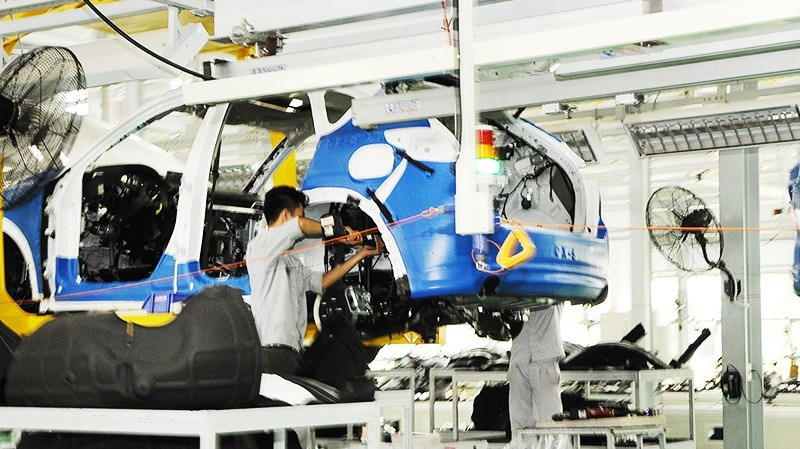Shaping industrial development lever through policy
Thirty years of renovation have granted the private sector the

Over the past 25 years of development, Phuong Linh Group has established a solid position in the industrial fan market, exporting more than 30% of its output abroad, with an average annual growth rate of 40%. However, Tran Van Le, Chairman of the Phuong Linh Group Board of Directors, could not conceal his concerns when mentioning the difficulties commonly faced by businesses.
"We have grown through experience gained on the job. Starting from a low base, lacking orientation and clear policy support, every time a crisis strikes, we suffer severe impacts," said Le.
Breaking the isolation of industrial enterprises
The story of Phuong Linh Group is quite typical of the development trajectory of industrial enterprises in recent times.
According to Cao Dai Thang, Chairman of the Board of Directors at INTECH Group, Viet Nam has experienced a very active period of attracting foreign direct investment (FDI), with many major global industrial corporations investing in the country. However, domestic industrial enterprises have found it extremely difficult to participate in the supply chains of FDI firms.
"Vietnamese industrial enterprises have been walking alone for a long time, fumbling along the path to find their footing in the market. The lack of direction and support mechanisms has prevented them from growing," Thang said.
According to Dr Nguyen Quan, former Minister of Science and Technology, building a strong force of industrial enterprises and entrepreneurs will play a crucial role in enabling Viet Nam to achieve high and sustainable growth in the coming period. Most importantly, a modern and breakthrough industrial strategy must be established.
Industrial enterprises are the "locomotive" driving many economies around the world. They are also a key engine for innovation and technology adoption. The building of a strong industrial base will provide new impetus for Viet Nam’s innovation-driven economic development.
According to statistics, the localisation rate in several sectors in Viet Nam is currently only around 5–10%. There are about 1,000 enterprises capable of directly supplying assembly firms and multinational corporations operating in Viet Nam, only around 30% of which are domestic businesses. These figures reflect that current industrial policies have not yet yielded their desired effect.
Modern, self-reliant industrial policies needed
Viet Nam has implemented numerous industrial development strategies and policies. Most recently, the “Strategy for Viet Nam’s Industrial Development to 2025, with a vision to 2035” and the “Master Plan for Industrial Sector Development to 2020, with a vision to 2030” issued in 2014.
These policies have brought about some encouraging results. The technological content and export value of industrial products have increased relatively quickly compared to other ASEAN countries. The processing and manufacturing sector now accounts for around 24% of GDP and is playing an increasingly key role in economic growth. However, experts note that after more than a decade of implementing the strategy, many shortcomings remain. For example, in the processing and manufacturing sector — a traditional strength of the Vietnamese economy — Dr Can Van Luc pointed out a major weakness: limited added value, especially within the domestic sector, which still heavily relies on FDI enterprises. Furthermore, linkages between domestic and foreign enterprises, as well as between large and small firms in the value chains of processing and manufacturing industries, remain weak.
"The competitiveness of Vietnamese industrial enterprises is still relatively low, especially in the processing and manufacturing sector. In particular, productivity in this sector remains low compared to the region," Dr Luc said.
Therefore, industrial policy must be renewed towards placing private enterprises at the centre, industry as the foundation, and innovation as the driving force for development. The policy focus in the coming period should be on enhancing access to capital, technology, markets, and improving the quality of human resources.
He also proposed that industrial policy should be designed to promote innovation and generate new growth drivers for the economy. These new policies must be carefully assessed with multidimensional impact evaluations on beneficiaries, and a suitable roadmap must be drawn up to avoid shocks to the economy.
From another perspective, Dr Nguyen Quan stated that Viet Nam must develop a sufficiently strong contingent of enterprises. Thus, it is necessary to design more mechanisms and policies relating to capital, labour, science, and technology, especially enterprise linkages, to foster mutual development such that Viet Nam can become a modern industrial nation by 2045.
Associate Professor Dr Nguyen Truc Le, Party Secretary and Chairman of the Council of the University of Economics at Viet Nam National University, Ha Noi, believes that in the context of global economic instability caused by geopolitical conflicts, increased trade protectionism, disrupted supply chains, and rising financial risks, for Viet Nam’s economy to achieve breakthrough double-digit growth, there needs to be a new perspective in addition to traditional incentive policies: redefining the role of industrial policy. Specifically, industrial policy must not only follow regulation but must precede to pave the way, generate momentum, remove barriers, and support stronger development of the private sector. A modern industrial policy must be enabling in nature and promote innovation and sustainable development. Viet Nam must proactively adapt to global trends such as digital transformation, green transition, and the restructuring of global supply chains.
Perhaps, as policy bottlenecks are gradually removed, the private sector will not have to walk alone on the path of industrialisation. Any breakthrough, if it comes, will originate from both intrinsic will and the policy levers that are increasingly taking clear shape.








